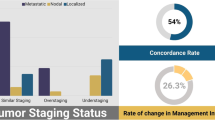Abstract.
Fluorine-18 fluorodeoxyglucose (FDG), the most widely used radiopharmaceutical in positron emission tomography (PET) for oncological purposes, is unsuitable for imaging of bladder cancer owing to high excretion into the urine. More specific PET radiopharmaceuticals which are not excreted into urine would be welcome. Carbon-11 labelled choline (CHOL) is a new radiopharmaceutical potentially useful for tumour imaging and is not excreted into the urine. We prospectively studied the visualisation of bladder cancer using CHOL PET. Eighteen patients with bladder cancer and five healthy volunteers were included. Bladder cancer was first diagnosed by transurethral resection or by biopsy of the tumour. Next, PET images were performed before surgical treatment by cystectomy. The histopathological findings after cystectomy were used as the gold standard. PET images were performed on either an ECAT 951/31 or an ECAT Exact HR+ system. Attenuation-corrected PET images were obtained after injection of 400 MBq CHOL. PET images were analysed by two independent physicians using visual analysis and calculation of the standardised uptake value (SUV). In the normal bladder wall, the uptake of CHOL was low, and the bladder margin was only outlined by minimal urinary radioactivity, if present. In ten patients the tumour was detected correctly by CHOL PET, with an SUV of 4.7±3.6 (mean±SD). One false positive CHOL PET scan was seen in a patient with an indwelling catheter for 2 weeks prior to the PET scan. In two patients, lymph node metastases were detected by CHOL PET. A micrometastasis <5 mm was not visualised with CHOL PET. In seven patients, no residual tumour was found after surgery. In six of seven patients CHOL PET imaging was negative. In situ carcinoma, dysplasia and a non-invasive urothelial tumour (pTa) remained undetected in three of these six patients. Minimal to no urinary tract radioactivity was seen in 22/23 subjects. Non-specific uptake of CHOL was observed in the small bowel, rectum and prostate gland. CHOL uptake in bladder cancer was avid, visualising the tumour in the virtual absence of urinary radioactivity. No uptake of CHOL was seen in pre-malignant lesions or in small non-invasive tumours. Our results warrant further research into the value of CHOL PET in the clinical management of patients with bladder cancer.
Similar content being viewed by others
Author information
Authors and Affiliations
Additional information
Received 6 February and in revised form 5 May 2002
Electronic Publication
Rights and permissions
About this article
Cite this article
de Jong, I.J., Pruim, J., Elsinga, P.H. et al. Visualisation of bladder cancer using 11C-choline PET: first clinical experience. Eur J Nucl Med 29, 1283–1288 (2002). https://doi.org/10.1007/s00259-002-0881-7
Published:
Issue Date:
DOI: https://doi.org/10.1007/s00259-002-0881-7




